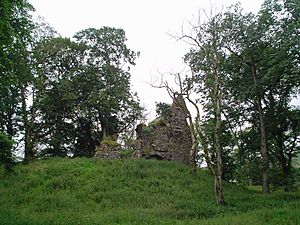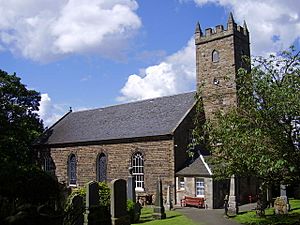Thor of Tranent facts for kids
Quick facts for kids
Thor (Thorald, Durand)
|
|
|---|---|
| Sheriff in Lothian | |
| Preceded by | none known |
| Succeeded by | Robert fitz Guy |
| Personal details | |
| Born | Unknown |
| Died | c. mid-to-late 12th century |
| Spouse | not known |
| Children | Sveinn, Alexander, William |
| Residence | East Lothian |
Thor of Tranent, also known as Thor, son of Sveinn, was an important landlord and leader in Scotland during the time of King David I of Scotland (around 1127 to 1150). He owned a large area of land called the "barony" of Tranent in East Lothian, which included places like Prestonpans. Thor was also a "Sheriff" in Lothian, which meant he was a powerful official who helped the king manage the area. We know about him because his name appears in many old documents, called "charters," from that time.
Contents
Thor's Role as Sheriff
Thor first appears in records around 1127. He witnessed a charter where King David gave land in Edinburgh to the church of St Cuthbert. In 1130, he also witnessed a grant from King David to Dunfermline Abbey about trading rights for ships at Inveresk.
Around 1143, Thor was called "Thor the Sheriff" in a charter from Stirling. This document showed King David giving a "salt pan" (a place to make salt) to Kelso Abbey. A year later, he was at Edinburgh Castle, witnessing another grant from the king. This time, land in Dalkeith was given to Holyrood Abbey.
Thor continued to serve as sheriff. Between 1143 and 1147, he witnessed a royal grant in Edinburgh. This grant gave a small piece of land, called a "toft," in Haddington to Dunfermline Abbey. During the same time, he also witnessed a grant from Earl Henry (the king's son) for lands at Duddingston to Kelso Abbey.
Around 1150, Thor witnessed a grant from Robert, who was the Bishop of St Andrews. This grant gave the church of Lohworuora (now Borthwick) to Herbert, the Bishop of Glasgow.
Thor's Own Charters
One of Thor's own charters still exists today. It is a copy found in the "cartulary" (a book of copies of charters) of Holyrood Abbey. In this charter, Thor gave his local church at Tranent to the abbey around 1150. Many important people witnessed this grant. These included William, the Bishop of Moray, and Osbern, the Abbot of Jedburgh. Other witnesses were Thor, the Archdeacon of Lothian, and Aiulf, the Dean of Lothian. Even Nicholas, a royal clerk who would later become the Chamberlain of Scotland, was there. Thor's own manager, called a "seneschal," Gille Míchéil, also witnessed the document.
The name of Thor's sheriffdom (the area he was in charge of) changed over time. It was sometimes called Edinburgh, Haddington, Lothian, or Linlithgow. This is why he is often known as "Sheriff of Lothian."
Thor's Family and Legacy

Thor had three known sons: Sveinn, Alexander, and William. All of them became important figures during the reign of William the Lion, who was king after David I.
Sveinn, Lord of Crawford
Sveinn was likely Thor's oldest son. Besides inheriting lands in East Lothian, he also became the lord of Crawford in Clydesdale. Sveinn had a daughter who became his heir. She married a knight named William de Lindsey. William de Lindsey was a very important judge in Lothian. His family later became the Earls of Crawford. Another "Sveinn son of Thor" was also the lord of Ruthven, a place near the border of Angus and Gowrie. Through his son Sveinn, Thor of Tranent is the earliest known ancestor of the Earls of Gowrie.
Alexander and William
Thor's other two sons, Alexander and William, had names that were not Scandinavian. Alexander seems to be the same "Alexander son of Thor" who was the Sheriff of Clackmannan between 1205 and 1207. Alexander's son, also named William, became the lord of Ochiltree in West Lothian.
William, Thor's third son, was the Sheriff of Stirling around 1165. By 1194, William's son, Alexander, had taken over from him. William also gave the church of Kirkintilloch to Cambuskenneth Abbey. This shows that his family was expanding their influence into the western parts of Scotland.
Place Names and Land Ownership
Two towns in Lothian, Thurston (in East Lothian) and Swanston (in Midlothian), have names that mean "Thor's village" and "Sveinn's village." These towns were likely founded during this time. Later, during William the Lion's reign, the land of Tranent came under the control of a new family called de Quincy.
See also


